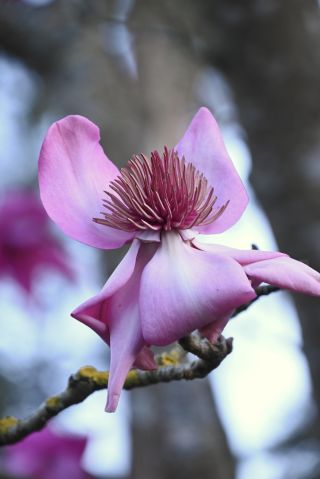Attention
What a Pandemic and a Little Bird Taught Me About Attention
A Personal Perspective: It can be hard to slow down enough to notice the world.
Posted February 17, 2023 Reviewed by Ekua Hagan

The white-crowned sparrow, a bird endemic to North America and once so local to San Francisco that they once had neighborhood accents, has begun its springtime call. The magnificent magnolia trees in Golden Gate Park’s Botanical Gardens have begun to unfurl their sumptuous velvet cups. Three years ago, in the spring of 2020, I wasn’t sure if I would ever experience these things again.
I remember riding my bike home from my clinic at the San Francisco VA the night that “shelter in place” was to begin. Nineteenth Avenue—which is also Highway 101 as it passes through the city and usually choked with traffic at rush hour—was eerily empty of cars. I found myself obediently waiting for a light to change when no cars were coming, uncertain if this new disease, then just called “the coronavirus” was going to take me like it had so many people in China. Feeling somewhat nihilistic, I rode against the red light, no cars visible for a mile in either direction.
It's easy to forget how frightened we were during those early days of the pandemic. There was so much uncertainty: Would the grocery stores run out of food? Did we need to sanitize our vegetables before we ate them? Could we actually succeed in “bending the curve?” What would we do while waiting at home for three weeks for this crisis to pass? Our naivete at that time now feels oddly endearing.
What is that bird?
During that March and April, most of my work, like that of millions of people, moved to a laptop on the kitchen table. I have a restless body, and it is difficult for me to stay in one place for very long. Fortunately for me, I’ve created a rich life in which my attention is frequently drawn from one task to the next.
But in those early days of the pandemic, my house began to feel like a prison. I’d often work until the end of the day, then ride my bike to the ocean, a few miles away, to watch the sunset (exercise was a permitted activity during shelter in place). On those bike rides, with the streets devoid of traffic, I would hear a bird call that I realized I had heard for much of the 20 years I’d lived in this city. Ah-tweee-tweee-twee-twee! Ah-tweee-tweee-twee-twee! Suddenly, it was much louder than I had ever heard before without the dull roar of the city to drown it out. A bit of Googling allowed me to identify it as a white-crowned sparrow, a tiny little ground-dwelling bird that could fit in the palm of your hand that returns to the same land—even the same shrub—for years to nest, generation after generation. It was always there, but I’d never really stopped long enough to pay attention and hear it.
As the shelter-in-place orders kept being extended and we began to realize this pandemic was not going away anytime soon, I decided to also channel my restlessness into art, making short videos of my time outside and setting them to music. I’d post them to YouTube for friends. They captured the melancholy I felt in those days, disconnected from friends and family, uncertain of the time to come, or if we would even survive to see it.
I remember checking the Johns Hopkins COVID-19 dashboard daily, astonished at the mounting number of cases and deaths. It’s hard for me to believe now, three years and innumerable boosters later, that the pandemic was once so prominent in our consciousness, its presence now brought to awareness by plastic barriers at shop counters and the occasional ubiquity (or conspicuous absence of) of masks. I realize my good fortune, having not lost anyone personally to the pandemic, something that the family and friends of over a million people who died in this country and nearly 6 million others internationally, cannot say.
That summer, I engaged in my favorite way to socially isolate, taking long solo backpacking trips in the Sierra Nevada. I made a film there, a slow pan across an alpine lake in the morning, the call of white-crowned sparrows in the background and set it to Neko Case’s “Maybe Sparrow” in which the Virginia chanteuse known for her enigmatic lyrics sings, “Maybe sparrow you should wait/The hawks alight ‘til morning/you’ll never pass beyond the gate/if you don’t hear my warning.”
What should I attend to?
The other day, I was riding my bike when I again heard the early sign of spring—the call of the white-crowned sparrow. What were the sparrows trying to tell me? To what was I being asked to pay attention? What lessons did the pandemic have hidden within the folds of its horrors?
I still grapple with this question, and probably will for some time to come. Like many good questions, it asks more in its query than the answer would probably satisfy, and in doing so, that makes it a good question, one to be returned to time and again. The English/Irish philosopher and poet David Whyte encourages one to query oneself with questions that “have no right to go away.”1
One answer that I have discovered is the pleasure of an occasional pause – to pet the dog when he requests my attention with his cold snout pushing up my typing hands; to stare off between the tree branches to the horizon; to enjoy the moment of real conversation with a friend; to stop and savor this breath.
I remain better at being occupied than being still, a practice that has both rewarded me and stolen from me. How many moments never to be repeated have gone unsavored because I was distracted by a seemingly important task? I cannot get those moments back, but I can practice not letting them continue to slip by unnoticed, at which I will likely fail as much as I succeed.




